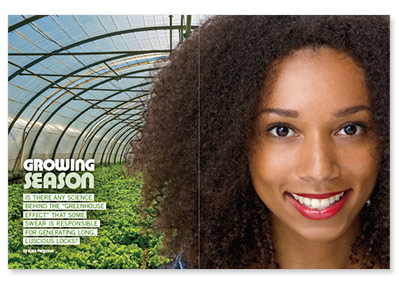
First, the science: The body has a hair growth cycle. Hair on the head grows on average one-half inch each month, growing faster or slower depending on your age, genetics and hormonal state.
Oh, and let’s not forget factors you can control, such as your nutrition and how well you take care of the tresses you already have on your head.
Now, if you ever visit a greenhouse, the first thing you may notice is the heat and humidity that hits you as soon as you step inside. In these controlled indoor environments, plants grow in profusion; their health and vitality are easy to see. The theory behind the greenhouse effect (GHE) on hair growth is similar, except you’re re-creating a hothouse environment atop your head to encourage your tresses to grow.
In general, the hair growth cycle consists of three key phases: anagen, when hair grows; catagen, when hair follicles shrink and detach from the cells located directly under the outer layer of skin; and telogen, when old hair rests prior to falling out to make way for new hair.
The greenhouse effect is used for hair growth and involves applying your favorite natural oil, blend of oils, or hair butters to either dry or damp tresses. Next, you cover your hair with a shower cap or plastic bag, and put on a scarf or some type of close-fitting headgear, such as a beanie or knit hat. Covering the hair generates heat, which is supposed to encourage the body’s production of more of your hair’s natural oils, or sebum, to moisturize your tresses, along with the oils you’ve used.
Many people also modify this routine by warming the oils and massaging their scalp to stimulate the hair follicles. Massaging any part of the body stimulates blood flow to that area. When blood flows to the scalp, this allows nutrients in the blood to nourish the scalp, and this helps hair to grow.
On the Internet, there’s a wealth of information about the greenhouse effect. You can also find a host of videos demonstrating how folks put the GHE into practice. What’s more, many of the videos include before-and-after photos that show hair growth attributed to GHE challenges done over the course of months and, sometimes, years.
One woman believes the warmth and humidity the GHE generates for her hair are comparable to the hot weather she swears helped her hair grow when she vacationed in the tiny tropical nation of Belize.
Still, there aren’t any scientific studies about how the greenhouse effect influences hair growth. But a few hair study findings do seem relevant to this technique. Results from one study showed that human hair growth is affected by seasonal changes in temperature and humidity. Another study found that tresses shed at certain times of the year when follicles undergo changes in the hair growth cycle.
In addition, other findings showed follicles entered certain phases of the hair growth cycle during seasonal variations triggered by temperature, sunlight and the body’s hormones.
Still, it’s key to remember that hair growth doesn’t occur in a vacuum. Simply rubbing natural oils and butters on tresses and covering your hair with plastic and hats won’t help locks grow if your health is poor in general and your diet is lacking in nutrients.






Comments
Comments